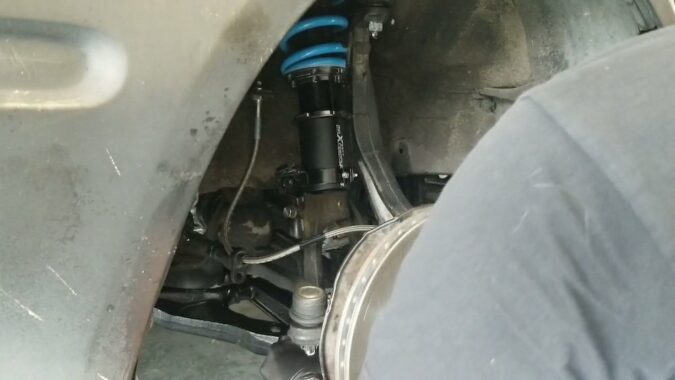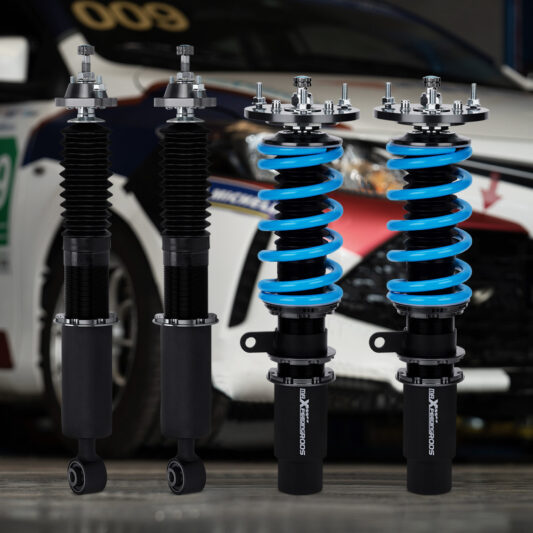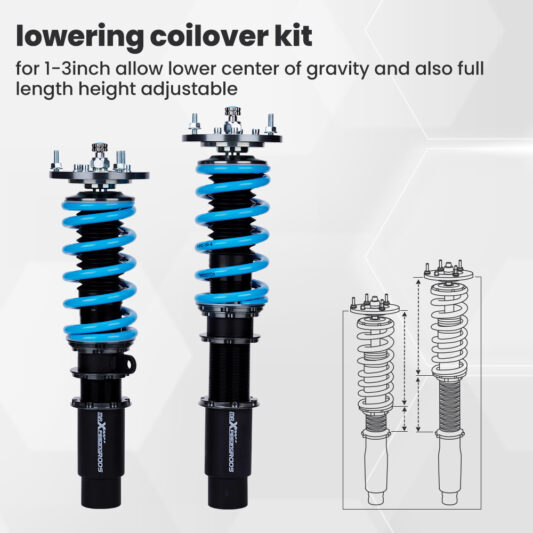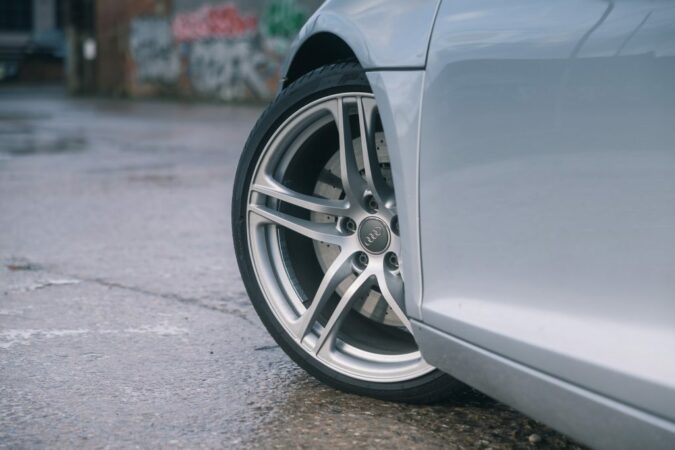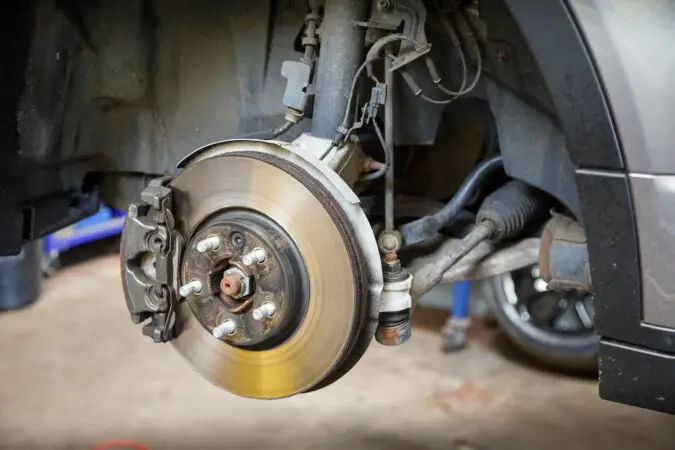Coilovers vs struts are two words that are very often used interchangeably to refer to pretty much the same thing. But in actuality, struts and coilovers are very different.
It is important to compare coilovers vs struts to help you make the right choice when looking to upgrade your suspension system.
Coilovers and struts refer to different configurations of coil springs and shock absorbers. There are vehicles where the coil spring and the shock absorbers are set in different positions. This means that it is the spring that supports the vehicle’s weight with the shock situated differently.
In this post, we aim to get a deeper understanding of coilovers vs struts to help you determine which type of suspension is best for your car.
For easier navigation throughout this post, feel free to use our table of contents below.
- Struts Vs Coilovers
- Shocks Vs Struts Vs Coilovers
- Difference Between Shocks And Struts
- Lowering Springs Vs Coilovers
- Coilovers Vs Shocks
- Air Suspension Vs Coilovers
- Frequently Asked Questions
Struts Vs Coilovers
Both struts and coilovers have shocks located inside the spring. Struts are designed to bear the weight of the vehicle. The struts have shock absorbers inside the strut assembly. Moreover, the spring will coil around the strut assembly itself. The spring however doesn’t cover the entire length of the shock absorber.
Coilovers on the other hand, have the springs going all over to the top of the shock. In that, they cover the entire shock absorber area.
Role Of Struts
Struts have a much more important role however than just absorbing the vehicle’s weight and impact. They also link the steering knuckle and the car. Simply put they also keep the car’s tires in an aligned position as well as offer support to the car.
That said, not only will they offer such a kind of support but they also carry the entire weight of the car. What we are saying here is that if you were to take out the struts, you will not be able to drive the car much less steer the wheels.
Many people continue to become confused when trying to tell the difference between struts vs coilovers. Simply put, you can think of a coilover as a spring or coil that is placed around a shock absorber or damper.
Part of the confusion lies in that coilovers also perform the same role of absorbing the weight of the car while driving over potholes and bumps.
Coilovers however offer more options when it comes to suspension tuning and adjustability. Because of this, they are more common with performance-oriented cars. Furthermore, they also allow you to adjust things like camber settings and change the ride height.
That said, coilovers will not support the weight of your car. If you were to remove the coilovers, you would still be able to drive your vehicle and steer. That said the car will have bottomed out.
Shocks Vs Struts Vs Coilovers
Another distinction that seems to play with the minds of many drivers is that between shocks vs struts vs coilovers.
Shocks essentially manage your suspension. They dampen the spring’s compression and reduce the speed at which the spring compresses when say you hit a bump.
When the car is parked the shocks are not doing anything. But when you take your vehicle say offroad, how quickly the springs compress due to the weight of hitting a depression is controlled by the shocks.
There are different types of shocks which may include small shocks, big shocks as well as performance shocks. While they are designed for different applications, their rile is pretty much the same.
Coilovers Vs Struts – The Struts
Unlike the shocks, The struts carry the weight of your vehicle. They allow the entire vehicle to go up or down pending on the conditions of the road.
The shocks in this case are situated inside the strut assembly. The spring will coil all around the strut assembly. It is advisable to service your strut assembly after every 60,000 to 68000 miles. If you live in an area where it’s salty, the struts will wear out even sooner.
Coilovers Vs Struts – The Coilovers
This is where the confusion reaches its optimum as people simply get confused trying to tell the difference between a coilover and a strut in car. After all, the coilover does go over the shock in both the strut and the coilover.
One of the major differences is that coilovers are adjustable which means that you can change the ride height as well as the level of dampening. This is why they are more common in performance cars and tuner cars.
While shock absorbers are a common feature in both the struts and coilovers a vehicle’s suspension system will have struts or coilovers.
Difference Between Shocks And Struts
While some people think that shock and struts are the same, the truth is that they are two different components both part of the vehicle’s suspension system.
Granted they both play a major role in managing the vehicle handling. They both have different functions.
The Shocks
Many people often think that the weight of the vehicle is supported by shock absorbers. However, this is not the case. The main role of shock absorbers is to control the suspension movement and the spring.
The shocks can do this by taking the kinetic energy and turning this into thermal energy. This thermal energy or heat is then dissipated via the shock fluid.
How much resistance a shock can absorb will come down to the suspension speed as well as the number of holes also called orifices that are located in the piston. Generally, the shocks will offer more resistance the harder the suspension moves. This is what allows the shock absorbers to adjust to the different conditions of the road.
Simply put, shock absorbers work just like an oil pump. It comprises a piston rod and at the need of it is a piston. The piston works against the hydraulic fluid that is in the pressure tube. While the suspension is traveling both up and down the fluid in the shocks is forced into the orifices.
Note how ere that only a small amount can pass through the orifices. This absorbs the speed of the piston slowing it down. As a result the suspension movement and the spring also slow down.
The Struts
Struts are common in modern front-wheel-drive vehicles as well as rear-wheel vehicles. Just like the shock absorber, the struts are also a highly important part of the vehicle’s suspension. They fulfill the job of the upper control arm as well as the upper ball joint that was common in conventional vehicle models.
Thanks to their more compact design, the struts are far lighter and consume less area than the shock absorber. That’s said, a strut is very similar to the shock absorber on the inside.
Functions Of Struts
Struts perform two major roles. The first role is to absorb the shock in a similar fashion to shock absorbers. The strut design is very similar to a shock absorber internally. It also features a piston connected to the end of the piston rod. Moreover, it also works against the hydraulic fluid allowing it to absorb the up and down movement of the vehicle.
Similar to shock absorbers, struts are also sensitive to velocity. This means that the faster the suspension moves the harder the resistance.
The second major role of the struts is providing structural support. This is not something that the shock absorbers are not able to do. They support the vehicle’s suspension system as well as offer support to the springs. They also ensure that the car is held up in a stable and aligned position.
It is also the struts that take on the majority of the side weight that is exerted on the car’s suspension system. This, therefore, means that a faulty strut (aka some bad struts on a car) will also be felt in the brakes, the wheel alignment as well as in the steering.
The struts are made up of the housing and inside the housing is the damping unit. The majority of struts are also connected at the bottom of the steering knuckle.
Lowering Springs Vs Coilovers
Many drivers opt to boost the performance of their vehicle’s suspension by lowering the car. Not only does the car appear more aggressive but it also gets much better handling. There are several ways that drovers do this. Each of these comes with its pros and cons.
Let’s consider coilovers, struts, and springs.
Coilover simply means coil set over the shock. Coilovers have a similar appearance to struts. Coilovers however allow for adjustability. If you were to lower both the springs and the coilover, you would be able to lower your car.
Many drivers wonder whether to lower the springs or to lower the coilover. While there are drivers who prefer the car is sitting lower, others want to increase or adjust the height of the ride.
Some car enthusiasts will prefer fully adjustable coilovers. They prefer coilovers that come with compression and rebound adjustments.
Coilovers Vs Struts – Lowering The Springs
The easier route would be to change the existing springs for lowered springs. Such springs will take the weight of the car without the need to make any modifications.
The lowered springs are shorter than the factory springs which in turn cause the vehicle to ride lower. Since the height of the spring is shorter than the stick, this gives the vehicle a firmer ride.
Many performance drivers prefer this as it keeps the vehicle steady and close to the ground.
Coilovers Vs Struts – Lowering The Coilovers
These can either be non-adjustable or fully adjustable. The non-adjustable coilovers are often an entry option. They feature height adjustability and come with a damper. That said, there are no adjustments for compression or stiffness, or rebound.
The non-adjustable coilovers are often ready to install and already preassembled.
Fully adjustable coilovers will take the place of the entire unit. When the shock and the performance of the spring features are equal it allows for optimum performance. Unlike the short springs we mentioned above, there is far more adjustability with coilovers. These include adjusting height, rebound, and even shock dampening. You can also adjust the camber.
Top-quality coilover kits are far more lightweight compared to the factory components. You can also adjust each coilover suspension for each corner allowing you to achieve optimum vehicle control and balance.
Coilovers Vs Shocks
Both coilovers and shocks make up the vehicle’s suspension system. However, while shocks do not allow room for adjustments and tuning, coilovers allow drivers to get far more control over the car’s suspension system.
Features
Both the coilovers and the shocks also help to manage the suspension springs. These springs cause the vehicle to bounce up and down whenever it passes over the holes and the springs. The coilovers will contain shocks. A better definition of a coilover is a shock that is wrapped in the spring.
Control
The coilover offers more control over the suspension system. This is especially the case when it comes to height. Furthermore, the driver can also evenly distribute the weight of the vehicle from the driers seat. This ensures the driver can create a good suspension regardless of the terrain on which he or she is driving.
The Usage
While each vehicle model will come with a standard for shocks, this is not so with coilovers. Coilovers however simple to install can be expensive to acquire. That said, they are common in off-road vehicles and high-performance cars.
Shock Absorbers – What They Do
As we saw, shock absorbers are just one part of your car’s suspension system. For most vehicles, there is a single shock absorber for each wheel. The shock absorber adds strength to the suspension system.
The role of shocks includes:
1. Stabilizing Body Movement
One of the major functions of shocks is to prevent the vehicle from swaying. The vehicle’s body moves up and down or will move from side to side depending on the conditions of the road. It is the shock absorbers that keep such movements in check.
2. Stabilizing The Ride Of The Vehicle
The terrain you are driving on can quickly change causing your driving to move from smooth to downright erratic. It is the job of the shock absorbers to ensure a stable ride. This is especially the case when you at turning a corner causing the vehicle to roll o one side. You can get more vehicle stability and control thanks to the shocks.
3. Stabilizing The Tires
The majority of vehicles will feature a shock absorber for each wheel and tire. The socks also put a huge amount of stabilizing force on the tires. For once it prevents the wheel of the car and tires from hopping whenever it hits the bumpy ground. This helps to keep the when and tire firmly grounded.
4. Reducing Wear On The Tires
Due to keeping the tire grounded and wheel stable, the shocks help to reduce wear and tear on the tires. When the tires are tightly held down will last longer than tires that are continuously bouncing off the ground.
5. Reduce Wear On Suspension
The shock absorbers are just one part of the vehicle’s suspension system. The majority of vehicles will also utilize leaf springs, struts as well as coil springs to control and stabilized the movement of the car. The shock absorbers will essentially absorb the shock that comes from road impacts as well as body movements. The amount of shock that is not absorbed by the shock absorber will be taken by other parts of the suspension.
Air Suspension Vs Coilovers
Both air suspension and coilovers are suspension kits and coilers are among the most popular suspension components. They help ensure a smooth ride for your car. But which of the two is better between the air suspension vs coilovers.
Air Suspension Kit
The air suspension is made of airbags that are at each vehicle’s wheel. Such vehicles also have an electric air compressor. Its role is to fill the airbags with air allowing the vehicle to rise to your required height.
There are many benefits of an air suspension such as offering one of the best suspension performances to rival any other type of suspension. This is because the air springs can absorb shocks from uneven surfaces in a much more efficient fashion. You are also able to adjust the air suspension kit.
The downside is that air suspension kits break down much easier and faster compared to other suspensions.
Coilover Suspension
These make use of springs set around a damper. There are those kits that can raise your vehicle while others will lower it.
While you can change the coil springs to achieve a much more comfortable ride, this does take some work than with the air suspension kits.
That said, coilover suspension kits are far more durable than air suspension kits.
Frequently Asked Questions
What Are Coilovers Vs Struts
Struts comprise strut housing and a dampener. They also contain strapping. Struts support the overall weight of the vehicle. Coilovers contain a dampener and a coil throughout the length of the dampener. They offer more adjustability allowing drivers to in the suspension to fit their needs and their car’s needs.
What Are Coilovers
Coilovers are a part of the suspension system and comprise a shock absorber and a spring coiled all around the dampener. The coilover allows for fine-tuning of the suspending height to meet the requirements of the driver and the vehicle.
What Is A strut On A Car
The strut is a part of the vehicle’s suspension system. The struts replace the upper control arm and the ball joint which is the norm in conventional vehicles. Compared to the shock absorber the strut is much lighter and consumes less space.
What Do Coilovers Do
Coilovers allow you to bring down and lower the suspension giving your vehicle a much sportier look and sportier handling. Coilovers also allow you to adjust the suspension hardness, compression dampening, or rebound.
Are Struts And Shocks The Same Thing
Struts and shocks are two different components that are part of the vehicle’s suspension system. While the shock is a single part, the strut comprises of the shock absorber and other parts to result in a single unit. Both the strut and the shocks keep the vehicle stable and the wheel firmly planted on the ground. Shocks prevent the vehicle from bounding down the road.
What Are Shocks
A shock absorber comprises a mechanical device that contains a hydraulic design that works to absorb the impact of uneven road surfaces on your vehicle. It takes the kinetic energy converts it to thermal energy and then dissipates the energy via the hydraulic fluid.
How Much Are Coilovers
The cost of coilovers depends on the type as well as the brand. That said, entry-level coilovers can cost anywhere from $600 to $1000. Intermediate-level coilovers can cost between $1000 and $4500.
How Long Do Coilovers Last
How long coilovers last will often come down to the usage of cash well as the type of driving. That said, if you want to add coilovers to your daily driving then this should last around the same as your OEM shocks. Some have had coilovers last for over 60,000 miles while still not getting any issues. Top-quality coil overs can last over 150,000 miles.
Do Coilovers Replace Struts
You don’t need to remove the struts to install the coilovers. They are a versatile suspension component that has the abilities of the strut while also including the dampening abilities of the shock absorber. It’s possible to install the whole assembly of the coilover as a single unit instead of having to remove the vehicle’s springs, struts, and mounts.
How Do Coilovers Work
Coilovers comprise of a spring that is wrapped around a damper. When the car hits a bump the coil will compress and as you enter level ground the spring is pushed back to normal position by the shock absorbers resulting in a very smooth ride.


